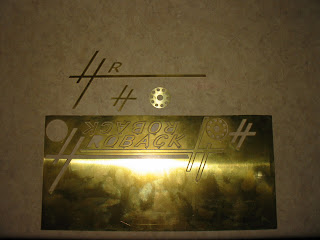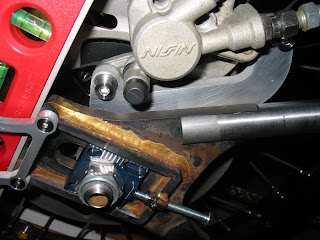Hi everyone! Sorry it's taken a while...
I finished the brackets, and have everything mounted up (minus the actual levers... more on that later)
Shift side
Brake side
I wanted to keep the "flowing curves" theme in the brackets to tie in with the rest of the bike. To me, it's a simple design, with just enough uniqueness. The levers will rotate around the peg mounts themselves right here...
They will be brazed to that rotating ring. (why was that so hard to explain last month?) I'm waiting for the levers to come from my waterjet cutter as I type this. I posted a pic of the design in my last post... I don't know if you saw it in the first of these 3 photos, but one of the 2 shift linkage rods was made and mounted to the shift arm. It's a combination of brass threaded rod, carbon fiber and stainless steel. Here's a close up:I wanted to incorporate carbon on this bike somewhere and I thought this would be the perfect place. It's really subtle, but I think it's perfect for the application. There will be 2 rods total, the one you see pictured (which will pivot around the lower foot peg mount) and another going from that lower mount to the lever itself. I LOVE mechanical movement, and having 2 rods moving with each shift makes me all excited. (Weird huh?) I know it's not as efficient as a single rod, but it's my bike and I can do what I want! :)
Last month, our friends Jodie and Dave came down from Chicago to visit. Dave is the guy I've mentioned before... he's a fo-real engineer and probably one of my biggest cheerleaders. He was excited to see the bike "in person" for the first time and the one thing he said that he didn't expect was how SMALL the bike was. That kind of surprised me so I wanted to see if I could capture the actual size better... I just measured the top-most part of the bike -which is the top of the fork tubes- and they measure 36.5 inches high. Or to say it another way, I'm just a tick under 5,9" and that's where my belt buckle is. Here's the bike leaning against my car. That should give you some perspective. I love that it's so small. Something about being low and long is just cool.
So I think that's about it for this post... I took a couple glamour shots while I was at it. Remember Glamour Shots at the mall? What girl in the 80's didn't do glamour shots? I should get all dressed up in a fancy, sparkly jacket, tease my hair up with a can or two of Aqua-net, stand sideways to the camera as I pull on my jacket lapels and smile a really big Hollywood smile! Maybe next time... think I'll get any more followers?
Glamorous baby, YEAH!
Ciao...












































